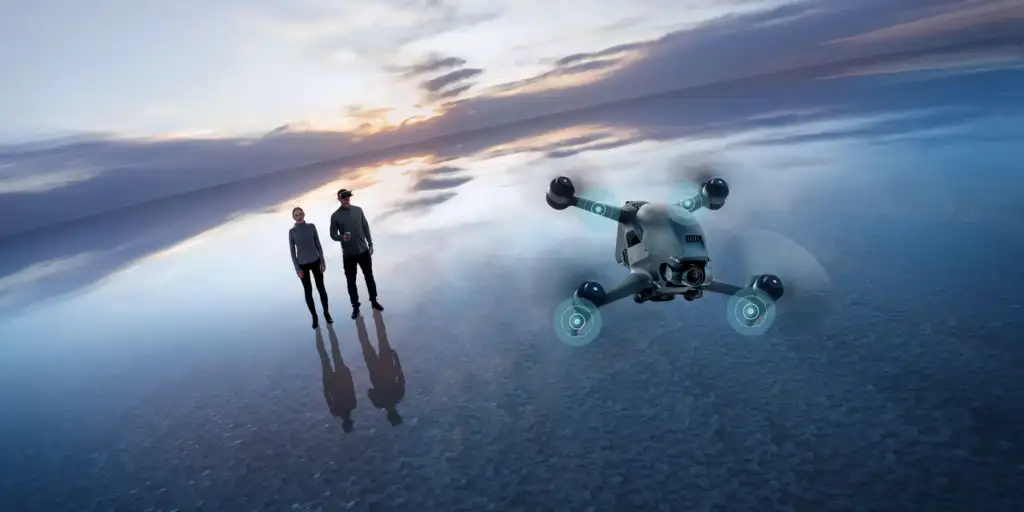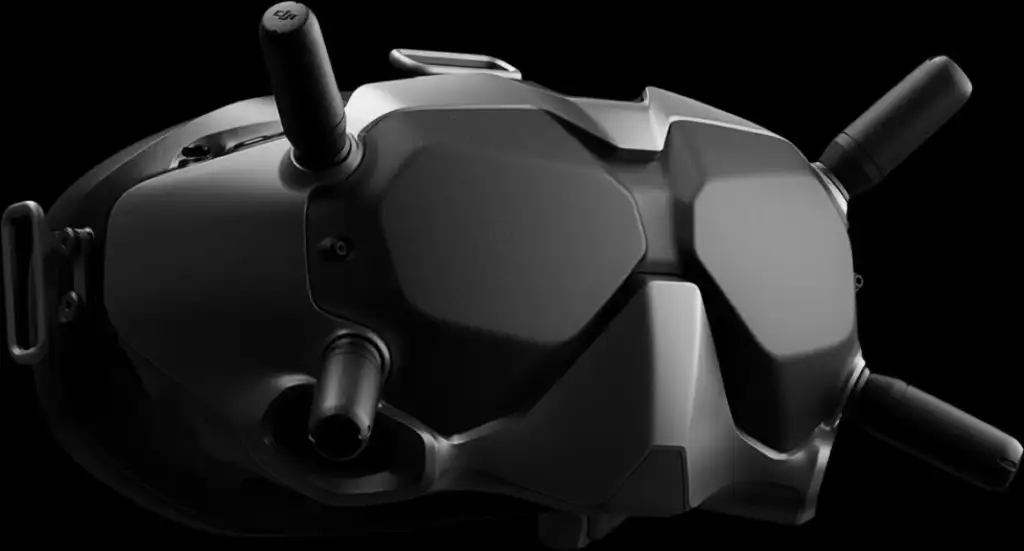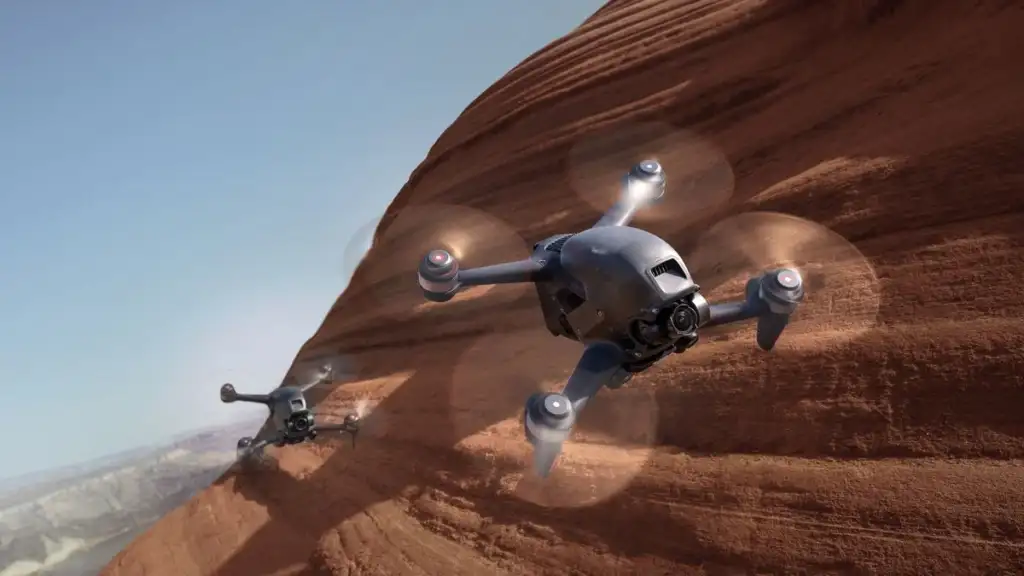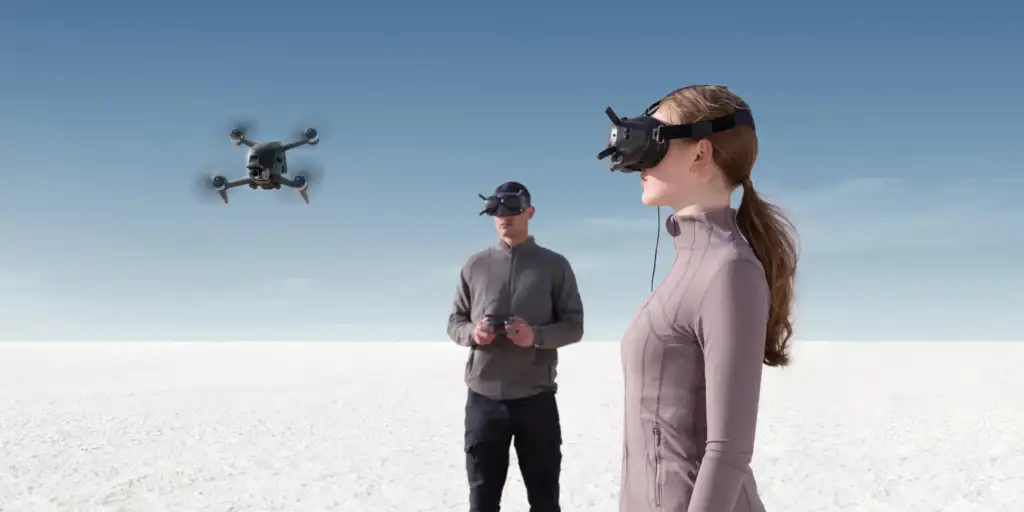Share This Article
Learn more
The DJI FPV marked DJI’s grand entrance into the entertaining realm of FPV in March 2021. Up until then, first-person view flying, or controlling a drone with goggles, has been seen as a sort of specialized activity. In terms of drone flying, the sport is similar to Formula 1 motor racing, and as such, the region has been populated by a few ardent drone enthusiasts who possess the extraordinary motor skills and hand-eye coordination needed to operate these machines.
The majority of these FPV pilots also needed to have the technical know-how, aptitude, and capacity to construct and assemble their aerobatic flying aircraft from kits of components before they could even take flight.
That is, until now. With the DJI FPV, a superbly built flying machine that makes FPV flying easy, enjoyable, and accessible, the Captain Slows of the drone world can now easily master this specialized drone category. Its simple controls and intelligent design make it one of the best drones we’ve tried, even though its camera may not wow those who prefer to concentrate on aerial photography.
Key Takeaways
- Fixed (non-foldable) frame
- ‘Chunky’ 795g/ 28oz weight
- Ergonomic & sophisticated controller, hand controller and headset
DJI FPV: OVERVIEW
The DJI FPV Drone delivers an exciting flying experience by fusing immersive first-person view (FPV) flying with high-speed performance. Its aerodynamic, streamlined shape is perfect for filming dramatic aerial shots because it is built for both stability and agility.

Description
Flying a drone for the first time is not advised as FPV flying is challenging. For experienced pilots, however, only one flight with the DJI FPV is probably going to hook you up. Just be careful not to wreck it unless you have a lot of money.Positives
- Good build quality
- Controller and Motion Controller ergonomics
- Fast with exceptional aerobatics
Negatives
- Headset adjustments could improve
- Headset strap quality rather poor
- Props visible in video
With a large range of vision and a 4K camera with a 150° wide-angle lens, the DJI FPV Drone provides remarkable pictures. With this sophisticated camera arrangement, you may be more creative knowing that every flight is recorded in brilliant colors and with high detail.
Reaching high speeds of 140 km/h (87 mph) is possible for the drone thanks to a strong propulsion system. Due to its high performance capability and advanced flying modes, pilots can make complex maneuvers and capture action shots of moving subjects quickly.
DJI FPV: SPECS
| Weight | Approx 28 oz. |
| Dimensions | 10×12.3×5 inches |
| Battery | 2000 mAh Lipo 6s/ Approx. 110 minutes |
| Charger | 100-240 V, 50/60 Hz, 1.8 A |
| Modes | Normal, Sport, Manual |
| Video transmission | Up to 6 miles |
| Video resolution | 4K |
| Frame rates | 4K/60fps video at up to 120Mbps |
The DJI FPV Drone boasts advanced safety features like obstacle avoidance and emergency braking in addition to controls that are easy to use. Through their emphasis on capturing spectacular footage and experiencing the thrill of flying in first person, these elements ensure a safer flying environment.
DJI FPV: DESIGN

There aren’t many drones on the market that resemble the DJI FPV. The sleek plastic look has a bit of HR Giger’s Alien mixed with a praying mantis vibe, and DJI’s Mavic range’s signature folding shape is gone. This aircraft, despite being lighter than, say, the Mavic 2, appears larger because to its upright body and fixed motor arms.
Related Posts
You’ll need a rather large bag to carry the drone because of its larger fixed dimensions; it should fit its 10×12.3×5-inch measurements. Propellers can easily bend during transit, so you’ll want to take them out before packing. Once you include the goggles, controllers, and batteries, you’re lugging quite a bit of technology.
Everything feels substantial in the hand, and you have a rather substantial 28-ounce takeoff weight after inserting the relatively large “intelligent” battery.
However, you must connect and establish contact between the drone, the DJI FPV goggles, and the controller or hand controller before to launch. The rationale behind the longish wire and separate battery for the goggles is that you can keep these extra parts in your pocket while flying. The remaining steps are essentially “plug and play,” and as soon as all the lights turn green, you can put on your goggles and get started.
We utilized the “main” controller for the first flight; other from lacking a phone cradle, it is structurally identical to other DJI controllers. But since you’re flying through the goggles and seeing everything in first person, you won’t miss this. When not in use, the control sticks are easily placed in the controller handles and screw into the controls. When you’re flying, it’s simple to control by feel instead than sight thanks to the huge buttons. All you need to do is get acquainted with the locations of the six buttons.
Moreover, the DJI FPV may be controlled by hand or motion. With its throttle grip and brake button, this controller is incredibly well-designed and unique from any other we have used.
Last update on 2025-04-25 / Affiliate links / Images from Amazon.
DJI FPV: FUNCTIONALITY
- Stills and video functionality limited
- Shoots good quality 4K and 1080p footage
- No raw photos or automated shooting modes

The DJI FPV has somewhat less moving picture and stills capacity than other DJI drones because it is designed more for recreational flying than for professional aerial video and photography. However, for an FPV drone, the video quality is still excellent at 4K at 50/60fps and 1080p at 50/60/100/120fps.
A 12MP 1/2.3-inch CMOS sensor with a fixed focal length of 14.66mm, 150-degree field of vision, and a fixed f/2.8 aperture is included on the DJI FPV. Theoretically, everything in the picture is in focus because of the fixed focal length range of 0.6 meters to infinity, and this seems to be the case.
Video footage can be recorded at a bit rate of up to 120Mbps in both Standard and D-Cinelike color profiles. The camera can record immersive video. Essentially, your preferred video editor need to offer an appropriate amount of dynamic range for you to deal with.
With the exception of the camera’s capture of the front propellers, the 4K and 1080p video appears decent overall and is suitable for uploading to YouTube. If the lens distortion option is activated, the barrel/fisheye distortion that the lens would otherwise produce is eliminated. Since this is an FPV drone, one significant distinction to note is that the gimbal only functions on the tilt (vertical) axis. However, picture stabilization (which borrows from the Osmo’s DJI innovation) fixes any problems and once more produces incredibly smooth video footage.
Although switching between video and still photography is simple and only requires a long press of the controller shutter button, the FPV’s photographic capabilities are less outstanding. As a result, the DJI FPV is not a drone you would choose for taking excellent aerial photos. There are just two modes “Auto” and “Manual” and they both record JPEGs. There are no automated shooting settings for stills or video that are familiar to Mavic users, nor is there a way to shoot in raw.
Hovering in any form of side breeze while taking stills presents another problem. Since there is no gimbal movement on the horizontal axis, the drone would automatically tilt in this situation to maintain position, which will lead to somewhat skew photos. Although this can be fixed in Photoshop (or Premiere for video) in post-production, all of this points to a drone that is ultimately made to perform at its best when recording forward-facing first-person point-of-view (FPV) video.
DJI FPV: PERFORMANCE
- Three flying modes make it suitable for novice FPV flyers
- Fast 87mph in Manual mode
- Obstacle avoidance sensors slow rather than stop

It turned out that operating the FPV drone was not as difficult as we had thought. Anyone who is already familiar with DJI’s Mavic series will also find this model to be very familiar.
With the knowledge gained from the Mavic series, the company has created a drone with flight modes suitable for both novice and expert pilots. However, the term “beginner” here is relative. It is highly recommended that you start with a conventional drone model if you have never flown one before in order to become comfortable with the controls and fundamental flight maneuvers. When compared to independently constructed FPV drones, the DJI FPV’s USP is its FPV component and how simple it is to operate.
Last update on 2025-04-25 / Affiliate links / Images from Amazon.
GPS positioning and the front and bottom visual positioning sensors of the FPV are used in “Normal” mode. For our initial flights, we set off in this mode and were happy to discover that, aside from the peculiar and slightly dizzying feeling of flying and seeing the world via the drone’s perspective, the handling was easy to handle and smooth, with a top speed of 33 mph.
The GPS and collision detection are disabled in “Manual” mode. Skilled FPV pilots can execute aerial manoeuvres and maneuver quickly around obstructions and confined areas in this mode. The DJI FPV can reach 87 mph in manual mode (0-62 mph in two seconds). It’s quite thrilling to experience the drone’s rapid acceleration and speed as well as its precise turning ability.
The ‘Sport’ mode combines some of the safety measures of the ‘Manual’ mode with some of the maneuverability of the ‘Normal’ mode. It’s definitely not slow; in fact, you can still attain speeds of up to 60 mph in this mode.
One key differentiator between the DJI FPV and other DJI models is that Mavic series drones stop instantly when their sensors identify an obstacle. Collider detection on the DJI FPV just slows down the drone and alerts you when there’s a chance of a collision, not trying to stop it or steer it away from danger. It means that even when using “Normal” mode, you should still fly the DJI FPV with great caution.
The immersive drone point of view makes a tremendous impact in FPV flight, regardless of the mode you choose to fly in. It truly is the closest thing to flying that you can experience without taking off your shoes. Although we had some difficulty using the dioptre sliders to calibrate the screen to our eyesight, the view is clear and sharp. It’s also difficult to read the flight information because part of it is on the edge of your peripheral vision due to the size of the screen.

It takes some getting used to changing the camera and flight settings on the goggles because it’s not as simple as cradling a phone on a controller. We spent a considerable amount of time fiddling with the controls on top of the headset and would have much preferred a system that accepted commands by requiring an eye movement or blink. It would be more logical to access the headset commands via the controller or motion controller, as this is likely still outside the capabilities of DJI engineers.
Speaking of the motion controller, we had a great time using it as a really lovely and novel way to operate the drone. Flying became easier and more natural due to the ergonomic design and placement of the throttle, buttons, and user interface controls. Point and shoot is exactly what it is! Simply press the trigger and aim the controller in the desired direction for the drone to go. To spin it, simply twist its wrist. Note that it is only compatible with Normal and Sports modes; Manual is not supported.
DJI FPV: VERDICT
This specific model is probably best suited for people who have had some prior experience flying drones and who have enough money in their bank account to cover the somewhat large initial cost and future repair expenses. The flying experience with the DJI FPV is very unique and provides an excellent introduction to FPV. However, there’s a reason why FPV flyers build their own lightweight, inexpensive kits.
It may be well-made from “advanced” plastics. However, it is quite unlikely that this drone will survive a high-speed collision intact. Therefore, considering this pricing and even with DJI Care refresh/insurance, it’s a potentially costly and hazardous venture.
Furthermore, even while the video specifications are excellent, the still imaging is not, which is likely enough to deter anyone who wish to capture excellent aerial photos. This device can fly quite quickly and defy the laws of physics! This is the drone for you if that’s what you’re searching for.
- IMMERSIVE FLIGHT EXPERIENCE: Feel the thrill of immersive flight provided by the DJI FPV...
- FAA Remote ID Compliant - DJI FPV complies with the FAA Remote ID rule. Please check the...
- 4K/60FPS VIDEO: The DJI FPV aircraft can record 4K/60fps video at up to 120 Mbps, capturing...
Last update on 2025-04-25 / Affiliate links / Images from Amazon.
Why Trust Factic
Berry Alex has been evaluating, testing, and reviewing tech, Household and travel items for several decades. He compiled all of the testers’ input, conducted extra research to assess each phone mount’s essential features and overall functioning, and reviewed professional profiles and verified customer reviews for each product.



